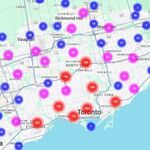You really do have a very elitist view of the world - I suspect you would like to live in a gated community so that the "awfulness of the world" could be kept out of sight. If you can manage to leave your bubble you should come and take a walk around St Lawrence where there are (expensive) condos, townhouses, co-ops and subsidised housing all mixed together and it is not easy to tell who lives where.
St Lawrence immediately came to mind for me too. Affordable housing has gone awry in a number of cases, but it needn't if planned and implemented well. St Lawrence is more inviting than ever to cycle through and stop and talk, let alone live.
Keesmaat's emphasis is on *rental housing* and her "100,000" figure is over ten years. Yes it's ambitious. It's also necessary, and if the right factors line-up, do-able. Some of those factors aren't in place, but other cities, most notably Vancouver in Canada, and many cities in the US, NYC, etc are moving to more flexible zoning that allows much more mixed usage (commercial/residential/employment) which has many advantages for a city and a society, *if done well*.
I do have an issue with Keesmaat that during her time as Chief Planner, she was part of Toronto's very rigid zoning policy, but that's another discussion. Here's a page from a profoundly forward looking and excellently produced NYCity report:
November 2014 THE NEW YORK CITY COUNCIL
Engines of Opportunity
MELISSA MARK-VIVERITO, SPEAKER
Reinvigorating New York City’s Manufacturing Zones for the 21st Century
167.153.240.175/downloads/pdf/NYEO.pdf
I highly recommend reading the entire chapter, let alone the full report. Other US cities with similar flexible zoning are studied in the report, some of them well to the 'Right' politically. It's not a case of political stance, it's one of enlightenment.
Vancouver has a milder approach, but the most progressive in Canada:
https://www.cityofvancouver.us/sites/default/files/fileattachments/vmc/titles_chapters/20.430.pdf
Excellent Globe article on it here:
Industrial grit meets residential glass in Vancouver - The Globe and Mail
And further to Van's approach, something I've been made aware of by discussion with an architect friend involved in designing and building in Austria (He's to the Cdn 'Right of Centre' btw):
REAL ESTATE
The Vienna model for housing sanity
No housing shortage, no waiting lists, no Ponzi scheme-like market scramble. Can Vancouver learn anything from the Austrian way?
FRANCES BULA
SPECIAL TO THE GLOBE AND MAIL
PUBLISHED MAY 26, 2017 UPDATED NOVEMBER 12, 2017
Vancouver and Vienna often end up on the top of the "most liveable cities" lists, ranked highly for their quality of life, air, health care and education.
But the two couldn't be more different in one crucial aspect.
Vancouver is a region racked by the negative effects of spiralling real-estate prices and rents, with people bitterly divided over the causes and solutions amid warnings that young people's futures, businesses and urban life are being seriously damaged.
In Vienna, 60 per cent of the population lives in social housing and rents are set so that people pay no more than 30 per cent of their income. There is no housing shortage, no years-long waiting lists for subsidized housing, no mad scramble to pour money into a real estate market that feels like a Ponzi scheme.
When the city releases land for new development, architects, developers and non-profit groups compete to come up with designs that demonstrate how they will create attractive living spaces and a socially integrated community.
This month, Vancouverites are getting a chance to look closely at what's called the Vienna model and talk about whether one city could learn lessons from the other.
The Museum of Vancouver is hosting the travelling exhibit the Austrian government has sponsored on the Vienna model – recently arrived from New York, where it was popular – and a series of debates and tours has been organized around that. In a city desperate for solutions, that's generated a lot of public interest.
"This is something to help a discussion of housing as a public good," says Sabine Bitter, an artist and professor at Simon Fraser University who helped bring the exhibition to Vancouver. "It's a way of showing how people can organize their life in the city differently."
The question is what exactly can Vancouver take away from Vienna? [...]
https://www.theglobeandmail.com/rea...-model-for-affordablehousing/article35128683/
Is Keesmaat's claim of "100,000 affordable units in ten years" do-able? Absolutely, but there's going to have to be a massive change in Toronto/Ontario mindset to do it. Even more than that number can be built. Austria is far from being alone doing this in nations with a higher standard of living than ours. And far better transit and overall livability too ...
Let the conversation begin...
Addendum: Just up at the Globe:
Vancouver removes perplexing roadblock to affordable housing
ADRIENNE TANNER
VANCOUVER
SPECIAL TO THE GLOBE AND MAIL
PUBLISHED SEPTEMBER 24, 2018 UPDATED 10 MINUTES AGO
Adrienne Tanner is Vancouver journalist who writes about civic affairs.
[...]
The solution gelled last week, when council voted unanimously to create the Vancouver Affordable Housing Endowment Fund. Its mandate is to finance and deliver, along with other partners, 72,000 units of truly affordable housing over the next 10 years. More than a third of the units will be geared toward households earning less than $80,000, including 12,000 units of social and supportive housing.
[...]
https://www.theglobeandmail.com/opi...s-perplexing-roadblock-to-affordable-housing/





